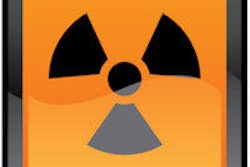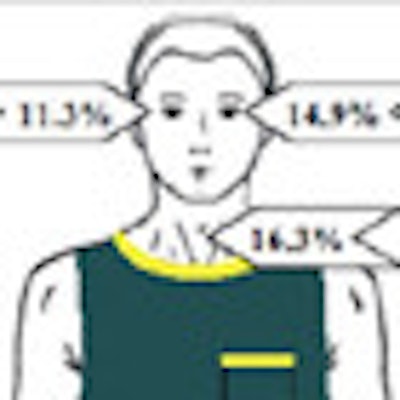
The rapid development of new cardiac stents and other medical devices is opening up a world of possibilities for interventional procedures in the cath lab -- but it's also exposing equipment operators to ever-higher radiation doses.
Researchers from Portugal found that those performing longer therapeutic procedures and using radial access are most at risk -- but a key problem was operators choosing to skip established protection measures.
"The radiation exposure to personnel who are normally protected by a lead apron can reach the critical range, especially in the area of the head and neck as the operators do not always wear thyroid shields or leaded glasses -- probably most of them because they never measured the dose and in Portugal because of a lack of studies in this area," said Graciano Paulo from the College of Health Technology in Coimbra, Portugal.
His group's study, presented at the 2010 European Congress of Radiology (ECR), analyzed radiation doses delivered to operators associated with common cardiac interventions in 221 patients, including 140 (63.3%) using a femoral approach and 81 (36.6%) using a radial approach. Procedure types were also split into two categories:
- Diagnostic (n = 160, 72.4%) included coronary angiography, ventriculography, hemodynamic studies, aortography, and carotid angiography
- Therapeutic (n = 61, 27.6%) included closure of interauricular communication, and percutaneous coronary angioplasty
"We developed a measurement of radiation exposure to operators during cath lab exams, considering the type of approach ... the type of procedure, and the type of protection, and we measured in different locations and also in different operators," Paulo said. The analysis measured exam time from initial puncture to finalization, the time of fluoroscopy, accumulated dose, dose rate, and exposure times.
Four operators worked with dosimeters (EDD-30, Unfors, Billdal, Sweden) attached at several locations on the body, including the left hand, the thyroid with and without shields, left and right eye lenses with and without protective goggles, and the gonads with protection. Measurements without established protection measures occurred when the operators declined to wear them, Paulo said.
The group also performed a survey of reported operator radiation levels in the literature. The results varied widely, a finding that Paulo attributed to a lack of homogeneity in the patient cohorts and reporting methods, as well as differences in equipment, protection methods, and equipment used.
"Another important issue is major differences in the exam protocol," he said. "I think it's important to harmonize the results -- or at least when we look at these studies, to know what we are looking at," he said.
The results showed that the left hand presented larger dose values in all parameters (for example, at 2.49 minutes of exposure: 33.18 µSv, 5.20 mSv/h).
The access point also showed significant radiation differences across procedure types. Comparing both approaches, there was significant difference (p < 0.05) between femoral (8.36 µSv) and radial (16.91 µSv) access.
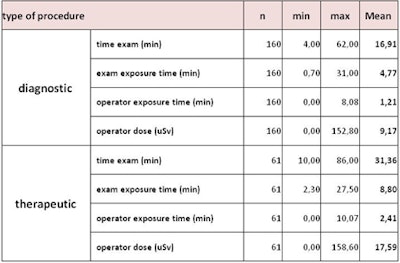 |
| Radiation exposure to operators during interventional cardiology, both diagnostic and therapeutic, shows a statistically significant difference (p < 0.05) in all variables between the types of procedures. All data courtesy of Graciano Paulo. |
The analysis found no differences in the actual radiation dose between femoral and radial access, and no differences in exam times and operator exposure times, but the operator dose was far higher in the case of radial access, Paulo said.
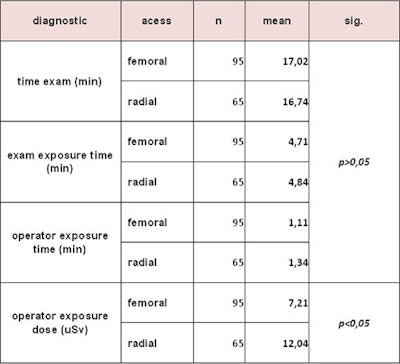 |
| Mean radiation exposure to different locations on the operator's body by access type, broken down by procedure times (above) and by mean radiation dose (below) for femoral and radial access. |
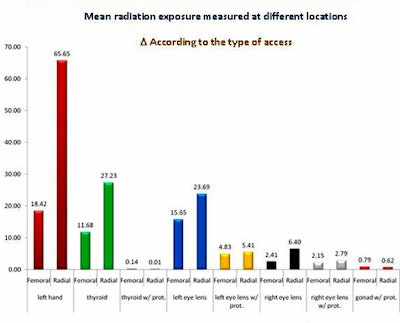 |
Comparing the results to those obtained in the literature survey, "we conclude that [ours] are around the lowest," he said. "However, it's important to be aware that it's still possible to decrease it."
Whether a procedure was diagnostic or therapeutic also mattered.
"When we analyzed the differences between the diagnostic and therapeutic procedures, we were not surprised to see [significant] differences between exam time and exam exposure times ... operator exposure times and operator dose," Paulo said.
Radial access is increasing in daily practice, and in some cath labs it's already routine. "It's important to recommend operators for extra protection measures when using radial access due to higher radiation exposure, because, of course, they are closer to the tube," he said.
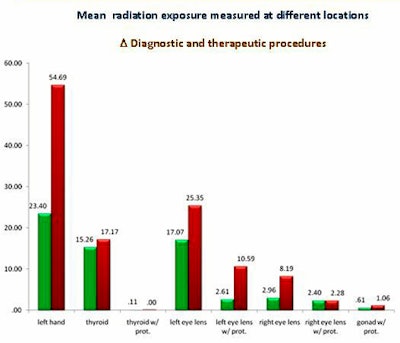 |
| Radiation exposure to operators during interventional cardiology for diagnostic and therapeutic procedures. Chart shows mean radiation dose measured at different locations on the operator's body. |
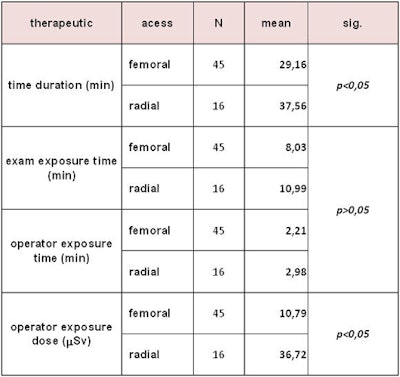 |
| Radiation doses to operators for therapeutic procedures. |
The group also found big differences in thyroid exposure depending on whether shields were used, and differences in eye lens exposure with and without protection.
"We found differences in left-eye lens radiation exposure, because goggle size was not adequate to the operator's face," Paulo said.
"Radiation protection is fundamental, but it must be adapted to operator characteristics," he said. "I think radiographers have an important role in promoting good practice regarding operators' protection."
Responding to questions from the audience, Paulo said that he tried to encourage the use of protective latex gloves with lead protection, but that some operators said they avoided them due to lost hand sensitivity when wearing them. But the study results appear to have shaken things up at the center.
"After the study they used 100% protection -- and thyroid protection as well," Paulo said.
By Eric Barnes
AuntMinnie.com staff writer
April 5, 2010
Related Reading
New paper updates guidelines on fluoro radiation injuries, February 18, 2010
FDA launches initiative to rein in medical radiation, February 9, 2010
Congress sets hearing to review medical radiation, February 8, 2010
NIH tells scanner suppliers to include radiation monitoring, February 1, 2010
FDA finds new cases of radiation overexposure, December 7, 2009
Copyright © 2010 AuntMinnie.com





